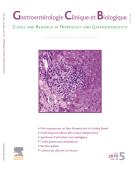IgA anti-actin antibodies in celiac disease - 27/09/10
 , N. Sakly a, A. Ayadi b, M.T. Sfar b, F. Amri c, A. Harbi d, A.S. Essoussi e, A. Krifa f, S. Ajmi g, I. Ghedira a, h
, N. Sakly a, A. Ayadi b, M.T. Sfar b, F. Amri c, A. Harbi d, A.S. Essoussi e, A. Krifa f, S. Ajmi g, I. Ghedira a, hSummary |
Aims |
The purpose of this study was to determine the sensitivity and specificity of IgA anti-actin antibodies (IgA-AAA) for celiac disease (CD), to investigate their usefulness as a marker of compliance in CD patients to the gluten-free diet (GFD), and to assess the relationship between their presence in the sera of CD patients and severity of intestinal mucosal damage.
Patients and methods |
A total of 182 patients with CD were studied: 63 patients were untreated; 50 patients were following a strict GFD; and 69 patients were non-compliant with a GFD. IgA-AAA was detected using a homemade enzyme-linked immunosorbent assay (ELISA).
Results |
IgA-AAA showed a sensitivity of 41.3% and a specificity of 71.4% for a diagnosis of CD. In children, the frequency of IgA-AAA detection was lower in those following a strict GFD (23.1%) compared with untreated patients (39.4%) and those not complying with a GFD (32.5%). In patients following a strict GFD, IgA-AAA detection was significantly less frequent in children than in adults (23.1% vs. 58.3%, respectively; P<0.001). IgA-AAA was found in 17 out of 52 CD patients with total villous atrophy (32.7%), and in one out of 11 patients with subtotal villous atrophy (9%).
Conclusion |
IgA-AAA cannot replace anti-endomysium and anti-tissue transglutaminase antibodies in the diagnosis algorithm of CD, but it can serve as a reliable marker of severe intestinal mucosal damage in CD patients.
Il testo completo di questo articolo è disponibile in PDF.Résumé |
Objectif |
Déterminer la sensibilité et la spécificité des anticorps anti-actine d’isotype IgA (AAA-IgA) au cours de la maladie cœliaque (MC), évaluer la relation entre leur présence dans le sérum de patients cœliaques et la gravité des dommages au niveau de la muqueuse intestinale, et déterminer leur utilité dans le contrôle de la compliance au régime sans gluten (RSG).
Patients et méthodes |
L’étude a porté sur 182 sérums prélevés chez des patients cœliaques. Soixante-trois patients sont non-traités, 50 sont sous RSG strict et 69 sont sous RSG mal suivi. Les AAA-IgA sont recherchés par une technique Elisa maison.
Résultats |
La sensibilité des AAA-IgA est de 41,3 % et sa spécificité est de 71,4 %. Chez les enfants, mais pas chez les adultes, les AAA-IgA sont moins fréquents chez les patients sous RSG strict (23,1 %) que chez les patients non traités (39,4 %) et ceux qui ne suivent pas leur régime (32,5 %). Chez les patients sous RSG strict, les AAA-IgA sont significativement moins fréquents chez les enfants que chez les adultes (23,1 % versus 58,3 %, p <0,001). Les AAA-IgA sont détectés dans 17 cas parmi les 52 patients cœliaques présentant une atrophie villositaire totale (32,7 %) et dans un cas sur 11 chez les patients présentant une atrophie villositaire subtotale (9 %).
Conclusion |
Les AAA-IgA ne peuvent pas remplacer les anticorps anti-endomysium et les anticorps anti-transglutaminase tissulaire pour le diagnostic de la MC. Cependant, ils constituent un marqueur fiable pour évaluer les dommages graves de la muqueuse intestinale chez les patients cœliaques.
Il testo completo di questo articolo è disponibile in PDF.Keywords : Celiac disease, IgA anti-actin antibodies, ELISA, Gluten-free diet, Tunisia
Mots clés : Maladie cœliaque, Anticorps anti-actine d’isotype IgA, Elisa, Régime sans gluten, Tunisie
Mappa
Vol 34 - N° 8-9
P. 483-487 - Settembre 2010 Ritorno al numeroBenvenuto su EM|consulte, il riferimento dei professionisti della salute.

